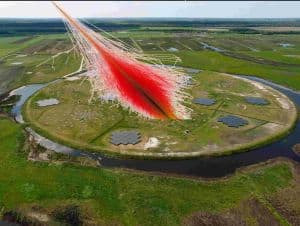Scientists Apply Simulation Code To Study Cosmic Rays And Identify Possible Sources
A group of scientists from the Karlsruher Institute of Technology has developed the CoREAS simulation which magnifies the cosmic array detection system of LOFAR (Low Frequency Array) radio telescope. When cosmic rays, signals that prove the existence of distant celestial objects, strike the Earth’s atmosphere high energy particles, they produce packets of secondary particle which are studied to understand the physics of space science.
Recently, LOFAR produced revolutionary results about the mass and potential sources of these particles which points at an abnormally high number of light particles, protons and helium nuclei, at energies of 10 to the power of 17 to 10 to the power of 17.5 electron volts.
Till now, LOFAR detected densely packed particles in the aforementioned energy range, which generally come from supernovas. However, the newly detected light particles signify that there might be a high energy source existing in our galaxy, or they have possibly originated from any extragalactic source. Scientists are aware of the fact that particle flux from galactic sources stops at a point and cosmic rays with a gigantic amount of energy can only be produced in extragalactic objects. However, in what exact range the transition takes place is still unknown to the scientific world.

This composite photograph illustrates a particle shower hitting the detector field in the center of the LOFAR telescope in Exloo, the Netherland
Here entered the KIT simulation, which could answer the above query with extremely high precision. Tim Huege of the Institute of Nuclear Physics of KIT claimed that with the help of the code, the LOFAR was able to detect signals accurately. LOFAR was established in the Netherlands to experience a breakthrough in the sensitivity of astronomical observations at radio frequencies below 250 Hertz. Numerous antennas were present that captured the cosmic arrays and extracted important information related to the mass of the particle and energy levels.
Huege explained that in order to accurately detect masses, the depth of penetration of secondary particles in the earth’s atmosphere is tested, which algorithmically depends upon the CoREAS code. CoREAS took 10 years to be developed and is built upon the CORSIKA code (Cosmic Ray Simulation for KASCADE), which was an existing technology till 2013.
Source: <a href="https://www.kit.edu/kit/english/pi_2016_030_nature-kit-simulation-analyzes-cosmic-rays.php" target="_blank" rel="nofollow noopener noreferrer">KIT - KIT - Media - Press Releases - Archive Press Releases - Nature: KIT Simulation Analyzes Cosmic Rays</a>
Recently, LOFAR produced revolutionary results about the mass and potential sources of these particles which points at an abnormally high number of light particles, protons and helium nuclei, at energies of 10 to the power of 17 to 10 to the power of 17.5 electron volts.
Till now, LOFAR detected densely packed particles in the aforementioned energy range, which generally come from supernovas. However, the newly detected light particles signify that there might be a high energy source existing in our galaxy, or they have possibly originated from any extragalactic source. Scientists are aware of the fact that particle flux from galactic sources stops at a point and cosmic rays with a gigantic amount of energy can only be produced in extragalactic objects. However, in what exact range the transition takes place is still unknown to the scientific world.

This composite photograph illustrates a particle shower hitting the detector field in the center of the LOFAR telescope in Exloo, the Netherland
Here entered the KIT simulation, which could answer the above query with extremely high precision. Tim Huege of the Institute of Nuclear Physics of KIT claimed that with the help of the code, the LOFAR was able to detect signals accurately. LOFAR was established in the Netherlands to experience a breakthrough in the sensitivity of astronomical observations at radio frequencies below 250 Hertz. Numerous antennas were present that captured the cosmic arrays and extracted important information related to the mass of the particle and energy levels.
Huege explained that in order to accurately detect masses, the depth of penetration of secondary particles in the earth’s atmosphere is tested, which algorithmically depends upon the CoREAS code. CoREAS took 10 years to be developed and is built upon the CORSIKA code (Cosmic Ray Simulation for KASCADE), which was an existing technology till 2013.
Source: <a href="https://www.kit.edu/kit/english/pi_2016_030_nature-kit-simulation-analyzes-cosmic-rays.php" target="_blank" rel="nofollow noopener noreferrer">KIT - KIT - Media - Press Releases - Archive Press Releases - Nature: KIT Simulation Analyzes Cosmic Rays</a>
0
